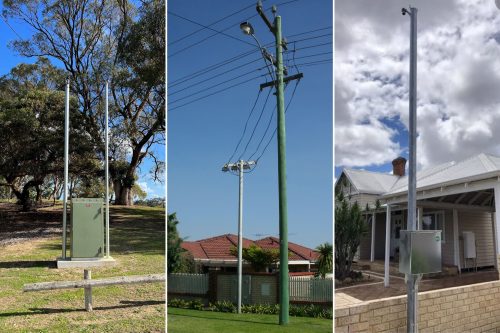Private overhead power lines transmit electricity from public infrastructure to buildings or other structures on your property. In most situations, private electricity pole infrastructure is needed to connect lines safely to residential or commercial buildings. Lines either split from the network operator’s overhead utility service cable or the switchboard/metre box junction situated just inside the property.
Many property owners in Western Australia have private power pole infrastructure. Expansive rural properties often require multiple private poles and overhead power lines.
At G&S Industries, we provide intermediate power connection poles made with the strength and integrity of steel that act as an intermediary between private power poles and the council power supply line. Here’s what you need to know when it comes to private power lines on private property.
Who’s responsible for installing private power lines?
In Western Australia, the responsibility for installing private power lines typically rests with the property owner. This responsibility includes installation and maintenance, with the property owner needing to ensure compliance with local safety regulations. This includes:
- Electrical lines and poles used for transmitting electricity from the main switchboard and metre to buildings or structures on the property
Electrical lines and poles that transmit electricity from the network operator’s power lines to the main switchboard and metre on the property - While the network operator (such as Western Power) is responsible for the distribution network up to the property boundary, anything beyond that point is the duty of the property owner. This includes all connections to individual buildings or structures. When installing any type of power infrastructure, the property owner needs to get the necessary council approvals.
During this process, it’s vital to engage qualified electricians and pole specialists. All people employed need to be licensed in Western Australia and have the appropriate skills and experience to undertake work on private power lines. At all times, it’s vital to ensure compliance with local regulations and safety standards.
Who’s responsible for maintaining private power lines?
Along with meeting electrical safety requirements during installation, the property owner needs to maintain the infrastructure to prevent hazards and disruptions over time. If you have a private power pole or lines on your premises, it’s your duty to regularly inspect and maintain them. Among other things, it’s important to keep trees and branches clear to prevent the risk of fire, electrocution, and power outages.
This responsibility is not a recent requirement in WA; it has always rested with property owners. It’s important to inspect your private power lines and poles on a regular basis, including stay wires, fittings, and other components. An annual inspection carried out by a licensed electrician who specialises in private power poles is recommended for most use cases, with additional inspections also needed after storms and other extreme weather events.
When inspecting lines, check for visible signs of deterioration. Depending on the problem, different professionals may be required to repair wires and/or poles. It’s important to never climb electrical poles or attempt to do repairs yourself. Contact with live wires can be deadly, so approach all infrastructure with the utmost care.
It’s recommended that you:
- Safely remove all vegetation on the ground that’s close to or under the power poles. All trees and branches should be at least two metres away from lines and poles.
- Check poles for obvious defects. If you have wood poles, check for cracks, rotting, and other damage. If you have steel poles, check for rust and integrity issues.
- Inspect all poles for structural issues, such as leaning or brackets pulling away. Check the integrity of lines and connections from a distance, including broken or damaged wires.
Who’s responsible for fallen private power lines?
If private power lines fall in Western Australia, the responsibility for dealing with them typically falls on the property owner. If you notice fallen lines, the following steps are recommended:
- Safety first: If you notice fallen private power, it’s crucial to treat them as live wires. Keep a safe distance and always remember: electricity can be extremely dangerous and potentially fatal.
- Contact the network operator: While you have a responsibility to maintain and fix private power lines, it’s still important to inform the network operator. In WA, this is often Western Power.
- Assessment and repair: The network operator is obliged to repair public infrastructure or connections. If you need a private pole replacement service, it’s important to contact qualified industry specialists, generally an electrician who specialises in power poles.
- Costs: Depending on the circumstances of the fallen lines or poles, there may be costs associated with repairs. Typically, property owners are responsible for these costs.
- Preventative measures: To avoid such incidents, property owners should regularly inspect and maintain their private power lines, using the guidelines listed above.
Private power pole replacement: wood vs. steel
Private power poles in WA vary significantly, with each type having a different cost and durability. In Perth, you may come across both steel and wooden power poles. For these private poles, you have the option to choose between hardwood timber, softwood timber, or steel. Jarrah is a common hardwood, pine is a common softwood, and steel which is commonly either a steel SHS pole or CHS pole. The cost to replace a private power pole depends on the size and material.
If poles have been in service for longer than their expected life, it’s important to have them replaced. Along with age, the condition of power poles varies significantly based on material, use, climate conditions, and underlying soil properties. Quality steel power poles are recommended for most situations, with galvanised steel often having a longer expected life and fewer maintenance issues among other benefits.
Need power connection poles? Contact G&S Industries!
Whilst our team doesn’t supply private power poles to homeowners, we do work with local councils and electricians, who supply and install power connection poles that act as an intermediate source between the council distribution line and the homeowner’s private power pole. Don’t hesitate to contact us today to see how our team can best assist you.
FAQs
The life expectancy of timber poles varies between 25 and 40 years, depending on the material and construction. The life expectancy of steel poles is 30 years or more, depending on galvanised materials, soil conditions, and concrete footings.
Along with the poles themselves, private power infrastructure could also include cross-arms, spreaders, wires, hardware, and other pole accessories. Typically, companies specialise in either poles or other infrastructure.
There are two 'corrosive' power pole application zones across the state of WA. Zone 1 includes coastal areas in the southeast and is characterised by benign soils and possible flooding. Zone 2 includes adjacent inland areas featuring saline soil conditions. For both zones, an additional corrosion protection coating is required to protect steel poles.

